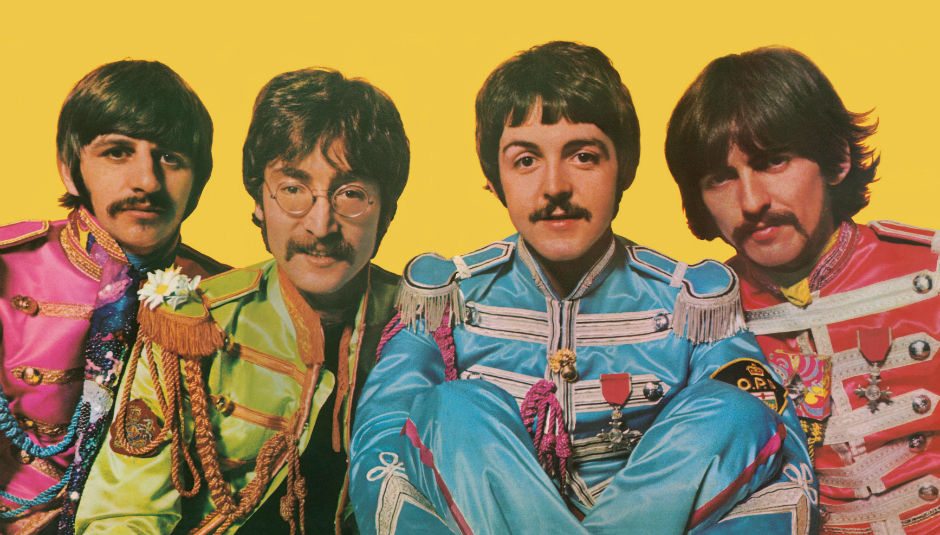It’s a warm, sunny evening in April and I’m walking over the most famous zebra crossing in the world. A bunch of tourists pass me, one barefoot, and I realise I’ve just ruined their photo. The waiting drivers look on impatiently as the group start to redo their photo against a soundtrack of beeping horns.
I walk down leafy Abbey Road in St John’s Wood and head into Abbey Road Studios. Life size cut-outs of John, Paul, George, and Ringo wearing their brightly coloured Sgt. Pepper’s uniforms are lined up outside in a nod to the iconic Peter Blake cover where cut outs of celebrities encircled the Beatles themselves. I’m here to attend a playback of a newly mixed version of Sgt. Pepper’s Lonely Hearts Club Band to celebrate the fiftieth anniversary of the album’s release. It’s a remix by Giles Martin, son of fifth Beatle and maverick producer George Martin and Abbey Road sound engineer Sam Okell.
Few albums in the history of music can claim to be as innovative or acclaimed as Sgt. Pepper’s Lonely Hearts Club Band. Recorded over 24 sessions in 1967, the album was a seismic departure from their early work after the band bravely decided to quit touring. Given carte blanche to do what they wanted in the studio with an unlimited budget, it afforded the band a new artistic and stylistic freedom with which to experiment and push boundaries – all at breakneck speed. “My father always said it was the pinnacle of their collaboration together,” Giles Martin tells a packed audience of over a hundred music journalists in Studio 2 where they recorded Sgt. Pepper’s. “The Beatles universe moved incredibly fast – it was an accelerative universe where they moved quickly, where they evolved fast.”
Adopting their Sergeant Pepper alter egos, the band ushered in the Summer of Love by mixing psychedelia with Eastern mysticism and old music hall with Avant Garde, creating one of the most sonically eclectic albums the world had seen. It won four Grammys including best album – the first rock album to do so – sold over 32 million copies, went platinum 17 times, and was named Rolling Stones’ ‘Greatest Album Of All Time’ in 2012. It redefined studio limits, became the first concept album, and brought art and music together with one of the most iconic album covers of all time.
Hearing the remixed version in Studio 2 is the stuff of goosebumps, especially hearing some of the 34 previously unreleased recordings that the new deluxe anniversary edition contains in the very studio where the album was recorded. The new version is mixed in stereo and 5.1 surround audio using the original mono recordings for what Martin terms “their spiritual guide.” The original mono is considered the definitive version after a hastily rushed studio version was produced later in just three days, with little involvement from band members. Martin plays the original monos alongside the new stereo versions to illustrate the differences whilst discussing the finer details of the four-month Abbey Road remixing project.
Two weeks later, I’m meeting Martin again, this time in his studio at Abbey Road. I’m led up to an intimate recording space, surrounded by a space-age mixing desk with thousands of buttons I eagerly want to press. Sat next to Martin in a swivel chair, I feel as though I’m a co-captain on the Millennium Falcon. He begins by making sure I’ve had a cup of tea; Abbey Road mug in hand, he warmly welcomes me into the studio where he sips his drink and we start to talk about the playback. “It’s funny,” he begins, when I congratulate him on the success of the night, “I’ve done quite a lot of them now. I did four in America and one at the Grammy Museum and I completed fucked it up. I was like ‘This is "Lucy In the Sky With Diamonds"’ and it wasn’t, I played the wrong song.” He tells me he’s just relieved it wasn’t by another artist.
Self-depreciation and modesty aside (the playback was brilliant), I ask the affable Martin how he felt taking on such a formidable project – mixing one of the most renowned records in history – and the thinking behind it. How do you appease the traditionalists – or the “socks and sandals brigade” as Martin terms them, with new audiences coming to the album for the first time?
“It’s hugely daunting,” Martin tells me. “My view is that if you can’t make it any better, there’s no point in making it different for the sake of it. We shouldn’t be doing it if that’s the case. I had some ideas because I knew what was on the original tapes. I produced the Love album in 2006 and the advantage of that is that we could go back to the previous takes, to the pre-bounced versions.”
“I started to think about how these would make the album feel – and it’s all about how the album feels. Driven by the original mono mixes we had some sort of spiritual guidance, even though it was just me and Sam in a room. I suppose the intention was to remember that John Lennon said: ‘You haven’t heard Sgt. Pepper’s until you’ve heard the monos’ and also me thinking: 'Well my kids listen to Kendrick Lamar – is it still going to hold up?'”
The project was completed with the blessing and consultation of the surviving band members and their families. “They’re my bosses. I will go and see Paul and Ringo, and Olivia and Yoko, and sit with them and listen to them. They make really valid comments and when you listen with others, you learn stuff. If they’re not happy, either I get fired or I have to go and redo it – it’s as simple as that. They are fully involved and it’s their record.”
He shows me a new vinyl test-pressing of ‘Strawberry Fields’ and ‘Penny Lane’ up close that has just been manufactured. His father George believed one of his biggest mistakes was the decision to allow EMI to release ‘Strawberry Fields’ and ‘Penny Lane’ as a double A-side single separate from the Sgt. Pepper’s album, even though they were recorded as part of the original album sessions.
Under pressure from EMI who felt the ten months between the release of Revolver and Sgt.Pepper’s was too long, the two tracks were released separately from the album to bridge the length of time between the two projects. On the deluxe edition of the CD, the two songs are fittingly included alongside their sister tracks for the first time, with three takes of ‘Strawberry Fields’ included and two versions of ‘Penny Lane,’ one of which is a beautiful instrumental, perhaps giving an indication of what part of Sgt. Peppers might have sounded if it had been toured.
With the outtakes never planned for release, I ask Martin about the process behind deciding what stays in and out, and the difficulty in going through all the original tapes. “I’d been through everything once already when I did the Beatle’s Rock Band project a while ago. I think I went through everything because I was looking for noises and speech for the game. In the end, it was just a quick run through. It was quite painful listening to everything – there’s so much of it! But it’s also the concentration level that you have to go through because you’re the only person listening to it. That was much more mind-blowing or taxing than doing the mix itself because you’re making decisions on stuff they didn’t release as opposed to stuff they did release.”
The music takes, he tells me, were somewhat easier. “There wasn’t a vast amount to go through – they were quite efficient in the studio. Things like ‘Fixing A Hole’ was three takes, the strings from ‘She’s Leaving Home’ are six takes so it’s not perhaps as huge an amount as you think. ‘Sgt. Pepper’s Lonely Hearts Club Band’ is nine takes; the one they played on the radio was take nine. The one I put in the extras on the album was actually the _Love _ final version, but without the overdubs on it. It was interesting in terms of the development of the song. The beauty of the project is in the simplicity of the fact it’s just them making noises. People look for the hidden magic: what button did they press to make this? And it, of course, wasn’t – it was grit!”
Using the original four-track tape recordings, the remix remains true to the mono whilst giving listeners the vibrancy and depth of a stereo remix. There are no added instruments or overdubbing – instead, there are production subtleties which give the original more texture, clarity, and volume as the original sounds are stripped back and allowed to breath. Instruments sound cohesive and the vocals are bright and airy. The instruments are also loud, just like they were in the live recordings from Studio 2, yet they now also seem to have an added dimension and depth, allowing the listener to appreciate all the intricate musical layering sometimes masked on the mono.
Highlights include the crisp harpsichord on ‘Fixing A Hole’, the volume of the trumpets on ‘Good Morning, Good Morning’ and the dystopian, orchestral crescendo of ‘A Day In The Life’ where the thump of the final piano is almost drone-like. Another is ‘The Benefit Of Mr Kite’, with the loud, Alice In Wonderland, circus-like whirls making you feel as though you are very much now inside one of the LSD trips that inspired the album.
When investigating the outtakes, one of Martin’s favourite discoveries was the use of ‘hums’ on the end of ‘A Day In The Life.’ The Beatles initially used a choir humming noises for the ending before deciding to use the piano that appears at the end.
“I didn’t know about these. Hearing the [later] piano take was also quite fun as well. When talking about things that surprised me, you think of this as a ‘studio’ album, but it wasn’t really – it was them playing live. When you pull apart a lot of records, they don’t sound as good, yet when you pull apart this record it is very beautiful. It sounds stupid of me to say Sgt. Pepper’s Lonely Hearts Club Band is a very well made record, but it’s a very well-made record. And that’s an advantage to us.”
“You are just trying to make things sound good. Sam and I just talk about it at length in the studio. We play around with it, we argue. Someone came up to me in America and said: ‘Oh we can really hear Ringo’s drums’ and then I started thinking, ‘Have we made the drums too loud?’ And then someone else says ‘Oh I really love the sound of the guitar’, someone else ‘I love the sound of Paul’s bass’, but you can’t tone up everything, otherwise it would be the same. But you can hear the textures on the record, and that’s the thing about it – it has so many textures on it. If you can hear them, then it’s actually better to listen to.”
I consider how difficult it must be for him, trying to appease all the different camps of fans – the traditionalists versus the new, and those who don’t want to see the originals touched, perhaps notably original sound engineer and ‘sixth Beatle’ Geoff Emerick. “There’s no worry. People think that, but there isn’t. You just do it, you have to be free – I sound like a hippy!”, he interjects. “But if you drive your car and you constantly worry about crashing, it won’t make you a better driver. You have to enjoy it and you have to rejoice in the fact you are doing it, otherwise you don’t push anything or you end up being too safe. I remember when I did Love and I played ‘Help’ to Paul. He said, ‘Well, this is just "Help". What have you done here?’ He encouraged me”, Martin says, in the true spirit of the band, “to constantly push the boundaries.”
Giles worked with his father since he was fifteen years old, shortly after George had started to lose his hearing. George died, aged 90, just before work on the Sgt Pepper project began. “It was a weird time. My dad passed away and then I took a week off. I came back in and I was in the studio downstairs and the first voice I heard was his, and that was kinda weird. And I suppose you suddenly realise,” he tells me, pausing, “that people go.”
“Yoko once said to me,” he continues, "'John is just a voice now’. We all die, we’ve all got that in common. The beauty about records is that they are a point in time. And that’s what’s great about seeing new generations react to them. What I like to think was great about the playback of the album in Studio 2 that night was that it was a collective listening experience. When I was doing the Love show in Vegas, my biggest fear was people thinking ‘Why did they make all these changes?’ I took ‘Yesterday’ to a big top tent to see what it sounded like on a PA system and everyone stopped doing what they were doing and just listened. And there’s something about that – it’s that shared moment that makes music and memory so important.”
The response to the projects Martin has previously worked on, such as 1 and Love, have been well received by Beatles aficionados, yet it wasn’t always the case at Abbey Road. “I did Love to impress my dad because I didn’t want to do crossover classical music anymore because I was stuck in this rut. When it came out they were all happy – The Beatles were happy, my dad was happy, and the fans were happy. I thought I was going to get crucified by everybody because here at the studio, I was getting crucified. At Abbey Road, they thought I was Satan. They didn’t like the idea of what I was doing.”
On hearing the finished result and seeing fan reaction, Abbey Road eventually came around. “It gives you confidence. There’s an element of risk involved. You have to take risks otherwise you don’t do anything. That project changed lots of things and they liked it – they heard it and people wanted more of it and they wanted to listen.”
“It also stopped the album from being these flat things because people go back and listen again. I remember doing an interview on Radio 4 and this woman said to me ‘I prefer the original version of Strawberry Fields to your version’ and I said ‘Yeah – you should do, it’s a better version!’ Mine was just a bunch of demos stuck together – but it’s making you listen to it and discuss it and that’s the point.”
The iconic artwork for the packaging for the deluxe edition has received just as much effort as the sound. Winning a Grammy, Peter Blake and Jann Haworth created the cover in collaboration with the band. The super deluxe edition features the pull-out sheet of Sgt Pepper cut outs, bonus posters and a new 144-page hardcover book which features new introductions from Paul McCartney and Giles Martin. It also contains further insights and essays by journalists and musicologists together with rare photographs and reproductions of handwritten lyrics.
“The passion we put into the sound side of things,” Martin tells me, “is equalled by the artistic team. I find them a pain in the arse when they write to me half way through saying ‘What do you think?’ and I’m like ‘I don’t care – I’m mixing!’ but then I saw the product and I suddenly respected them – it’s absolutely incredible.”
“I think we did a good job of remixing Sgt. Pepper’s , I think people like it.” He makes it clear, however, that the project today wouldn’t have been as successful had it not been for the innovation of the original recordings. “The original tapes really bloody don’t sound old. We don’t clean anything up - there’s no digital cleaning. People used to do that and I hate it. The recordings themselves are as good or better than recordings that happen now. The engineers [back then] were really, really good and they knew what they were doing. There’s a wariness…we couldn’t do a better job than they did. It’s just new technology – we’re mixing for now and they were mixing for fifty years ago.”
Martin tells me he particularly enjoyed the work on ‘Lucy In The Sky With Diamonds’, mixing old and new techniques together to powerful effect without losing the spirit of the original. “It was probably how we chopped the keyboard up and then got away with it,” he says of one of the most satisfying elements. “Doing that and just saying: 'OK, we can use artificial double tracking (ADT), we can use the same techniques as they did' and then realising I could play it to different fans and no one really cared I was doing that because they just felt they were still listening to The Beatles.”
In what will surely be one of the most exciting and well received Beatles re-mixing projects in decades, I ask Martin about the satisfaction a project like this must bring. “You’re never satisfied – you’re always wary of that legacy I suppose. It’s never like – job done. But I can go home and switch off. I play with my girls and I’ll take the dog for a walk – I’m really good not thinking about it at home and switching off.”
I ask him if he ever discusses the work at home. “My wife doesn’t really like the Beatles. When I first met her, I asked her what he favourite Beatles song was and she said it was ‘Daydream Believer'. ‘8 Days a Week’ was up for a BAFTA and a Grammy last year…I asked my wife if she liked it or not. ‘Not really, too much Beatles!’ It’s perfect she’s not into them.”
The deluxe versions of Sgt. Pepper's Lonely Hearts Club Band are out now via Apple Corps Ltd/Universal Music. For more information, please click here.























